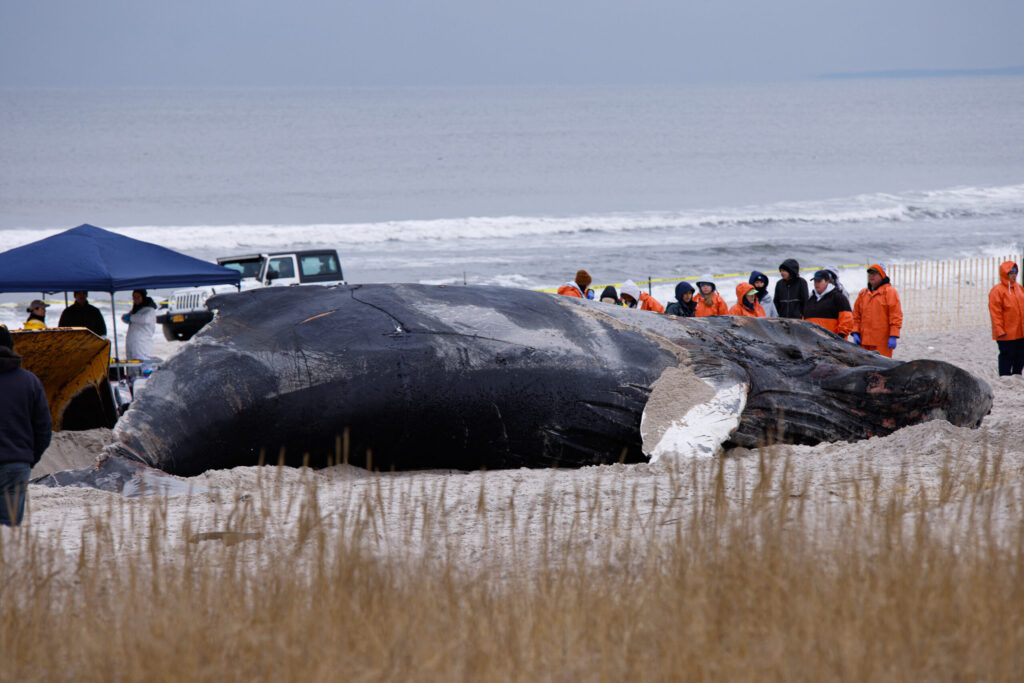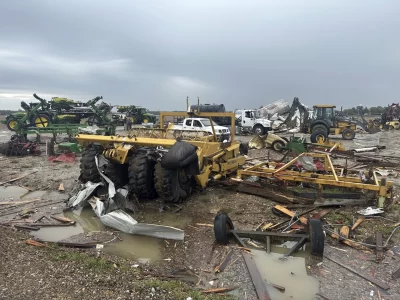
TOPSHOT - The carcass of a humpback whale lies on Lido Beach, New York, on January 31, 2023. - The male humpback washed up on the shore of Long Island early January 30. (Photo by KENA BETANCUR / AFP) (Photo by KENA BETANCUR/AFP via Getty Images)
Last March, a California giant perished. The 49-foot humpback nicknamed Fran washed up on a beach in the coastal city of Half Moon Bay. Fran had visited these waters for the entirety of her 17-year life, easily recognized by Californians due to the distinctive markings and shape of her tail.
This massive marine mammal provided crucial data to help scientists understand the intricacies of humpback feeding and breeding behavior—information crucial to the long-term survival of this enigmatic species.
A later necropsy revealed that the beached whale had a fractured vertebrae, severe chest bruising and her skull was dislocated from her spine, all injuries consistent with a ship collision. This whale’s suspected death is not the first of its kind—not by a long shot.
Shipping, cruise and fishing vessels fatally strike an estimated 20,000 whales around the world annually. In the United States, 80 endangered whales become “ocean roadkill” each year off the West Coast, and more than a third of all Atlantic right whale deaths along northeastern coastlines can be attributed to ship collisions.
These numbers are likely an underestimate because many large shipping vessels may not even be aware that they’ve hit and killed a whale—and carcasses will often sink to the bottom of the ocean before being documented, according to David Sims, a senior research fellow at the Marine Biological Association in the United Kingdom.
“I don’t think people realize that there are these unrecorded, undetected fatal collisions with some of the world’s most iconic and charismatic species,” Sims said.
To combat this, governments must better track when and where ship traffic overlaps with marine mammal migratory routes, and reduce ship speeds or reroute traffic in those areas, according to a recent Nature comment paper co-authored by Sims.
However, there is another factor making this issue increasingly complex and unpredictable: climate change. A growing body of research shows that climate-driven ocean warming and increasingly frequent marine heatwaves are throwing many whale migrations out of whack, which could push these marine giants into new ocean regions and closer to busy shipping lanes.
Getting It Wrong With Right Whales
The Gulf of Maine is one of the most crucial feeding grounds for the endangered North Atlantic right whale, which has just 340 individuals remaining in the ocean. The main item on the menu? Millions of tiny crustaceans known as copepods.
“It takes a lot of food to maintain these huge animals. And in order to maintain that size when the food that right whales are eating is smaller than the size of a grain of rice, you have to be able to find a lot of it and in really dense patches,” said Erin Meyer-Gutbrod, an assistant professor at the University of South Carolina who studies whales.
To protect these giants as they eat, the National Oceanic and Atmospheric Administration (NOAA) enacted a speed restriction rule in 2008 that requires vessels 65 feet or larger to slow to 10 knots, around 12 miles per hour, during certain times of the year in designated ocean zones.
Monitored by NOAA’s Office of Law Enforcement, these fixed “Seasonal Management Areas”—the equivalent of school zones for whales—can be found along the northeastern coast where the North Atlantic right whales migrate and feed, including Maine. They were chosen based on historical data of when and where the right whales pass through a certain region.
However, due to the effect of climate change on ocean circulation, there has been a steep drop in copepod abundance throughout Maine in recent years. As a result, whales have been forced to seek other areas to forage in the waters of Cape Cod and the Gulf of St. Lawrence near Canada, leaving them vulnerable to new threats, according to a 2022 study led by Meyer-Gutbrod.
The whales’ initial arrival in these areas was unexpected and few policies were in place to protect them, which led to a devastating mortality event between 2017 and 2019, in which 20 North Atlantic right whales were found dead in the Gulf of St. Lawrence. Ship collisions were responsible for at least eight of these deaths, necropsies revealed.
“There’s a mismatch between where the right whales are distributed and where the policies are distributed,” Meyer-Gutbrod said. “If you’re protecting the Gulf of Maine, but the right whales are, in fact, in the Gulf of St. Lawrence, you’re going to have a big problem.”
The Canadian government has since enacted voluntary and mandatory seasonal slowdown zones in this region from around April to June and late September to November, which has helped reduce vessel strikes in this area, authorities say.
Last year, NOAA proposed changes to its 2008 ruling that would expand mandatory slowdown zones during certain times of the year along the East Coast to reflect the right whale’s changing ocean habitats, yet this amendment has been met with vehement opposition from members of the fishing community.
Though the bill is still stalled in the House Appropriations Committee, NOAA received $82 million in funding this month under the Inflation Reduction Act to invest in North Atlantic right whale conservation. Roughly a quarter of this funding will be dedicated to reducing vessel strikes, according to the federal organization.
A Bicoastal Dilemma
North Atlantic right whales aren’t the only species facing up against maritime fleets: Blue whales, humpbacks and gray whales on the West Coast are forced to bob and weave through ship traffic on a daily basis. Each year, NOAA issues voluntary slowdown requests from May 1 to December 15 off San Francisco, Monterey and Southern California to help curb collisions, and the zone expanded throughout the Monterey Bay National Marine Sanctuary in 2023.
However, just because these voluntary restrictions are in place along the East and West Coasts, doesn’t always mean that companies are following them.
“You can issue a rule, but we know from our highways when you get close to the city, you’re gonna get cars driving 30 to 40 miles over the speed limit because there’s not enough enforcement to actually make sure that cars are going the speed limit,” said Elliott Hazen, a research ecologist at NOAA’s Southwest Fisheries Science Center.
Federal officers do not monitor or enforce voluntary speed reduction areas. However, a group of scientists worked together in 2020 to create their own set of eyes in the sea. Compiling data from acoustic monitoring buoys, whale habitat models and reported whale sightings, experts led by the University of California Santa Barbara’s Benioff Ocean Initiative developed Whale Safe, an app used to track whale populations off Santa Barbara and San Francisco and give near-real time updates on their presence to ship captains in the area.
The app also monitors shipping and cruise vessels to determine how often these ships are actually sticking to the speed limit. While many operators have been compliant the majority of the time in these areas, others—including Pasha Hawaii Holdings LLC, Great White Fleet and Catalina Express—have missed the mark, cooperating with slow down zones less than 15 percent of the time over the course of the season, according to data from Whale Safe. None of these companies responded to requests for comment.
Shipping vessels and fishing boats have cited that speed reduction areas around the country will make it unfeasible to meet their deadlines or effectively run their businesses. However, other companies, such as the Mediterranean Shipping Company, a container shipping line headquartered in Geneva, have been compliant with these zones in California more than 90 percent of the time.
In the Santa Barbara Channel, where some of the world’s largest shipping companies—including Maersk, the Mediterranean Shipping Company and Evergreen—are participating in an incentivized speed-reduction initiative known as the Protecting Blue Whales and Blue Skies Program, which started in 2014. Led by NOAA, the program offers companies up to $50,000 if they are compliant with slowdown zones, though many companies choose to decline the incentive at the end of the season and the money is instead used to sustain the program.
The added bonus? Slowdowns can help ships reduce their climate-warming emissions: In 2022, shipping companies in the program reduced their air pollutant emissions by approximately 920 tons of nitrogen oxides and 32,000 metric tons of regional greenhouse gasses, NOAA says.
“I think at the industry level, nobody wants to hit a whale,” Hazen said. “Industry is on board if we can give solutions that can allow them to maintain their economic footprint as well as reducing ship strikes.”
Learning From ‘The Blob’
Climate change isn’t just manifesting itself in the form of steadily warming ocean temperatures: Severe and rapid-onset marine heat waves are becoming more frequent and longer lasting, too, which can cause drastic changes in marine mammal behavior.
“Marine heat waves can result in pretty large redistribution of species like whales,” Hazen said. “To be able to get out in front of that … and then being able to assess what that means for speed limits, suggested or mandatory, is going to be critically important.”
For example, in 2015 and 2016, a severe marine heat wave known as “The Blob” permeated the West Coast, causing ocean temperatures to rise almost seven degrees Fahrenheit above average. During this heat wave, blue whales, the world’s biggest mammals, migrated into the Southern California Bight coastline earlier and hung around longer than usual, leading to higher overlap between shipping vessels and the whales, according to a 2021 study co-authored by Hazen. This area stretches 430 miles from Point Conception in California to Punta Colonet in Baja California in Mexico.
Though the researchers were not able to determine how many vessel strikes occurred during the heatwave because “the vast majority of whale ship collisions go undocumented,” modeling showed that the massive marine mammals were at a much higher risk at this time, said Briana Abrahms, an assistant biology professor at University of Washington who led the study.
The researchers also compared the effectiveness of fixed strategies that implement speed limits at the same time every year—the current approach in California—versus dynamic strategies that enact speed limits in response to whale habitat conditions seasonally or daily. Their models suggested that dynamic strategies were up to 10 percent more effective at preventing lethal collisions as compared to the fixed approach. This flexible policy could also help NOAA avoid implementing vessel speed limits that may affect shipping supply chains at unnecessary times of the year because the whales “might actually not show up until later or leave sooner” than was expected, Abrahms said.
Marine heat waves are not isolated to the West Coast; in 2023, heat wave conditions were documented in waters off the northeastern coast. In August, Florida waters reached bathwater-like temperatures of around 101 degrees Fahrenheit, decimating local coral populations.
As climate impacts continue to unfold, scientists are working to better predict where whales will be during certain times of the year, said Hazen. And policies to prevent ship strikes must be able to adapt at an equally fast pace, research shows.
Fran, the California humpback, could not be saved in 2022. However, a piece of her lives on in West Coast waters: A few months before Fran’s death, she gave birth to a calf named Aria. The young orphan successfully survived her first migration from California to Mexico and back, and was last spotted in May splashing around outside of Santa Cruz, according to Happywhale, a citizen science app that tracks whales around the world.
As Aria continues to share these waters with shipping companies, real-time data and dynamic slowdown zones could help her and other whales around the U.S. avoid a similar fate as the calf’s mother, researchers say. But given the vagaries of climate change, forecasts for how whale movements will overlap with ship traffic remain relatively uncertain, and preventing ship collisions may come down to the creation of new, fast-acting slowdown policies—and the willingness of ship captains to follow them.






